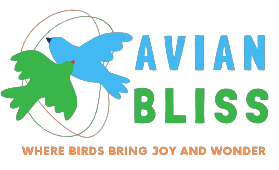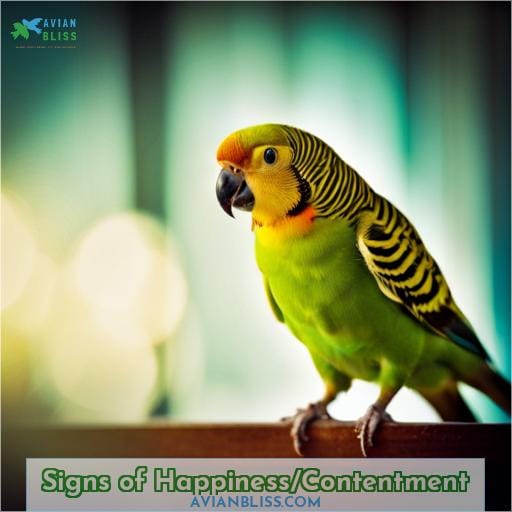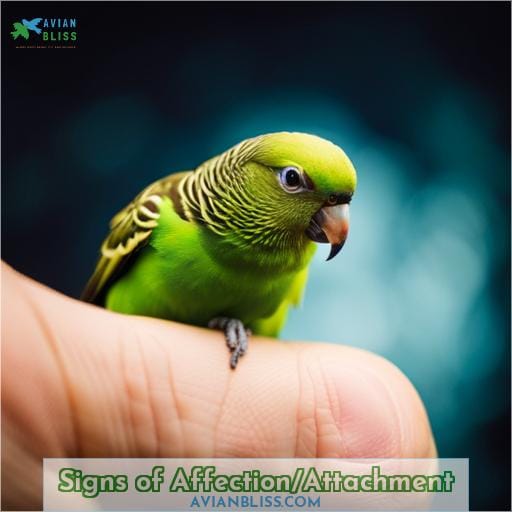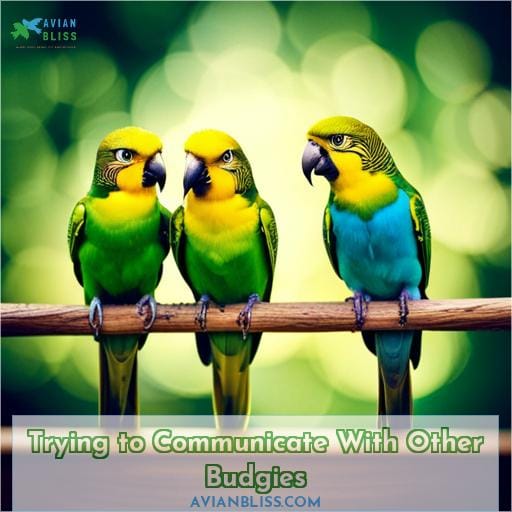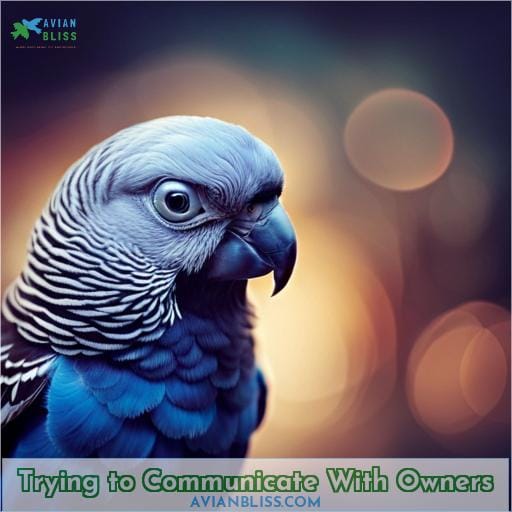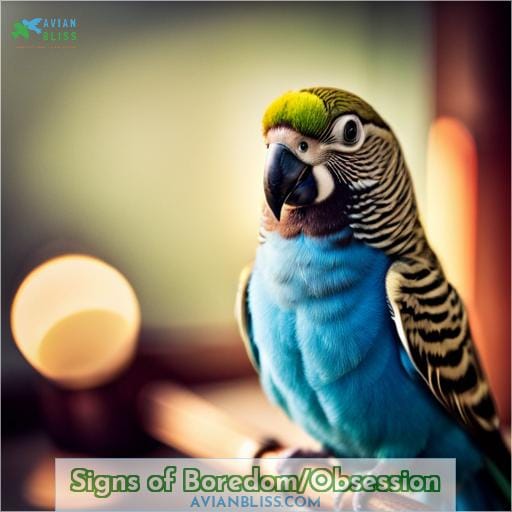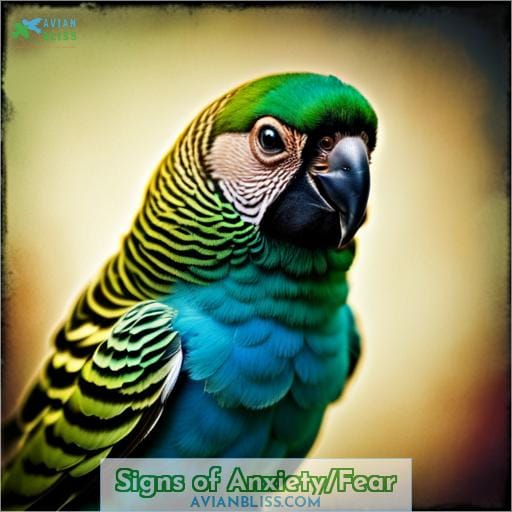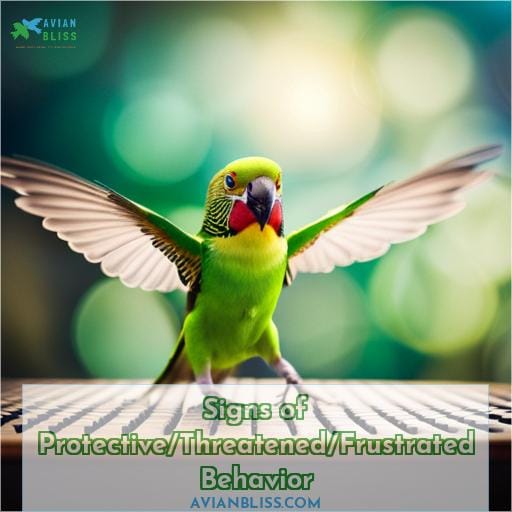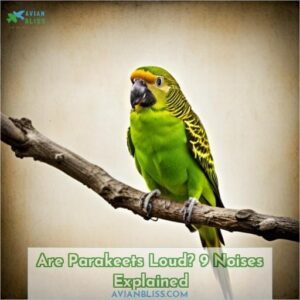This site is supported by our readers. We may earn a commission, at no cost to you, if you purchase through links.
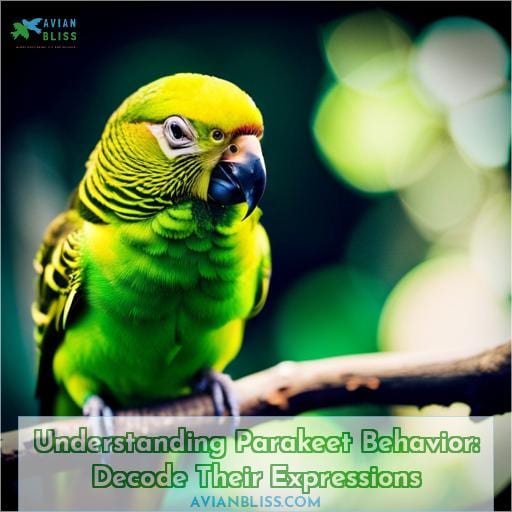 Step into the fascinating world of parakeet behavior and unravel the mysteries behind their expressive actions. Ever wondered what your feathered friend is trying to convey? This guide will equip you with the knowledge to understand and interpret their signals accurately.
Step into the fascinating world of parakeet behavior and unravel the mysteries behind their expressive actions. Ever wondered what your feathered friend is trying to convey? This guide will equip you with the knowledge to understand and interpret their signals accurately.
From signs of happiness and affection, to attempts at communication with other budgies or even you, this article will decode their expressions so that you can nurture a strong bond with your parakeet companion.
Table Of Contents
- Key Takeaways
- Signs of Happiness/Contentment
- Signs of Affection/Attachment
- Trying to Communicate With Other Budgies
- Trying to Communicate With Owners
- Signs of Boredom/Obsession
- Signs of Anxiety/Fear
- Signs of Protective/Threatened/Frustrated Behavior
- Signs of Illness/Pain
- Frequently Asked Questions (FAQs)
- How do I know if my parakeet is experiencing happiness or contentment?
- What are some signs that my parakeet is showing affection or attachment towards me?
- How can I tell if my parakeet is trying to communicate with other budgies?
- What are the ways in which my parakeet tries to communicate with me, its owner?
- What are the signs that my parakeet is bored or obsessed with something?
- Conclusion
Key Takeaways
- Signs of happiness and contentment in parakeets include singing, talking, flapping wings, shaking tail or tongue, singing with you, pecking at your ear or hair, becoming attached to things, and regurgitating food.
- Signs of affection and attachment in parakeets include head bobbing, chirping happily, singing with you, pecking at your ear or hair, preening, and leaning against your hand or cuddling up next to you.
- Parakeets communicate with other budgies through head bobbing, chirping happily, and beak tapping or pecking at the cage bars.
- Parakeets communicate with their owners through head bobbing, chirping happily, flapping wings, tilting head while making soft chirping sounds, bobbing tail up and down rapidly, flying towards you or landing on your shoulder, and stepping up onto owners’ hands or fingers.
- Signs of boredom or obsession in parakeets include becoming bored with things quickly, plucking feathers, refusal to chew on toys provided for enrichment, destructive behaviors, loud screaming, and regurgitation behavior.
- Signs of anxiety or fear in parakeets include screaming, trembling, hunching their body, excessive flapping of wings, chirping loudly, bobbing their head, and resorting to plucking their feathers.
- Signs of protective, threatened, or frustrated behavior in parakeets include purring, biting, growling, hissing, flattening their beak against a surface, lunging towards perceived threats, and tail swishing motions accompanied by rapid wing flapping.
- Signs of illness or pain in parakeets include weight loss, changes in vocalizations, increased hiding behavior, decreased activity levels, and dull feathers lacking their natural luster.
Signs of Happiness/Contentment
When your parakeet is happy and content, you may notice them:
- Singing joyfully or even talking to themselves.
- Flapping their wings in excitement.
- Shaking their tail feathers with delight.
- Becoming attached to certain objects or individuals, showing affection by pecking at your ear or hair.
- Regurgitating food as a display of contentment and trust towards you as their caregiver.
Singing, Talking, Flapping Wings, Shaking Tail or Tongue
If your parakeet is displaying signs of happiness or contentment, you may observe them engaging in activities such as:
- Singing
- Talking
- Flapping their wings
- Shaking their tail or tongue
These behaviors serve as expressions of joy and satisfaction for budgies.
Singing can occur frequently throughout the day at various pitches and volumes.
Talking may involve mimicking words or phrases they’ve learned from their environment.
Wing flapping and tail/tongue shaking are often done with speed and enthusiasm to release pent-up energy.
Singing With You, Pecking at Your Ear or Hair, Becoming Attached to Things, Regurgitating Food
One clear sign that your parakeet is expressing happiness and contentment is when they:
- Sing with you
- Peck at your ear or hair
- Become attached to things
- Even regurgitate food.
These behaviors show affection and a strong bond between you and your feathered friend. They demonstrate trust in their companionship with you. It’s a beautiful expression of love from your parakeet that can bring joy to both of you.
Signs of Affection/Attachment
When it comes to signs of affection and attachment, parakeets show their love for their owners in various ways.
One common sign is head bobbing, where the bird rapidly moves its head up and down as a way of expressing excitement and happiness towards you.
Another sign is regurgitating food, which may seem strange but is actually a display of trust and bonding. By offering you partially digested food, your parakeet is showing that they see you as part of their flock or family.
Preening is another form of affectionate behavior where the bird gently nibbles at your hair or ear to groom you like they’d with other birds in their group.
Additionally, some parakeets will lean against your hand or cuddle up next to you when they feel comfortable and safe in your presence.
Trying to Communicate With Other Budgies
As your parakeet tries to communicate with other budgies, you may notice certain behaviors that indicate their desire for social interaction.
One common behavior is head bobbing, where your parakeet rapidly moves its head up and down.
Additionally, chirping happily is another way for them to express their desire for companionship. By vocalizing in a cheerful manner, they’re inviting other budgies into their social circle.
Another behavior to look out for is beak tapping or pecking at the cage bars when they see or hear other birds nearby. This indicates that your parakeet wants attention from its feathered friends and wishes to establish contact through visual cues or sound patterns emitted by others.
Trying to Communicate With Owners
As social creatures, parakeets often try to communicate with their owners in various ways.
One common behavior you may notice is when your parakeet perches near you and tilts its head while making soft chirping sounds.
Another way they try to communicate is by bobbing their tail up and down rapidly, which can indicate excitement or anticipation of interaction.
If your parakeet flies towards you or lands on your shoulder, this signifies trust and affection towards you as its owner. It’s important to respond positively by giving them attention and gentle petting if they enjoy it.
Additionally, many parakeets are trained to step up onto their owners’ hands or fingers when prompted. This behavior shows that they recognize the hand as a safe perch and are willing to interact with you closely.
Understanding these communication attempts from your feathered friend will help strengthen the bond between both of you.
Signs of Boredom/Obsession
If your parakeet is becoming bored with things quickly or plucking feathers, it may be displaying signs of boredom/obsession.
Boredom in parakeets can lead to various behavioral issues that indicate their dissatisfaction and need for stimulation.
One common sign is the refusal to chew on toys provided for enrichment.
Instead of engaging with these objects, they might resort to destructive behaviors such as plucking tail feathers or pacing back and forth restlessly in their cage.
Another indicator is loud screaming, which could be a cry for attention and mental stimulation from their environment.
Additionally, some parakeets may exhibit regurgitation behavior as a means of self-soothing when they’re feeling unfulfilled or overwhelmed by boredom.
It’s important to address these signs promptly by providing new toys, interactive playtime sessions outside the cage, and opportunities for mental engagement through training exercises or puzzle toys.
Signs of Anxiety/Fear
When your parakeet is experiencing anxiety or fear, you may notice signs such as:
- Screaming
- Trembling
- Hunching their body
These behaviors are their way of expressing distress and unease.
In addition to these obvious signs, there are other subtle cues that can indicate anxiety or fear in your parakeet.
- Exhibit excessive flapping of wings
- Chirp loudly in an attempt to alert others about the perceived threat
- Bob their head, which can be a sign of nervousness or apprehension
- Resort to plucking their feathers as a coping mechanism for stress-induced anxiety
If you observe lethargy along with these behaviors, it could be an indication that your parakeet is feeling fearful and anxious due to certain triggers in its environment.
Signs of Protective/Threatened/Frustrated Behavior
When your parakeet is feeling protective, threatened, or frustrated, they may exhibit signs such as:
- Purring
- Biting
- Growling
- Hissing
These behaviors indicate that your feathered friend is trying to communicate their discomfort or unease.
You might observe them:
- Flattening their beak against a surface in an attempt to assert dominance and establish boundaries.
- Lunging towards perceived threats with raised feathers on the back of their necks and p■-up bodies as a sign of aggression.
- Tail swishing motions accompanied by rapid wing flapping; this indicates frustration and agitation.
It’s important to respect these signals from your parakeet and give them space when they display these behaviors so that they feel safe and secure in their environment.
Signs of Illness/Pain
As much as we try to create a safe and nurturing environment for our parakeets, there may be times when they experience illness or pain. It’s important to be aware of the signs that may indicate their discomfort so that we can provide them with the necessary care and attention.
Look out for any:
- Weight loss
- Changes in vocalizations, such as decreased singing or an abnormal tone
- Increased hiding behavior
- Decreased activity levels compared to their usual energy levels
- Dull feathers lacking their natural luster
These signs can serve as red flags alerting us to potential health issues that require veterinary intervention. By recognizing these indicators early on and seeking appropriate medical assistance promptly if needed, we can ensure that our beloved feathered friends receive the help they need in a timely manner.
Frequently Asked Questions (FAQs)
How do I know if my parakeet is experiencing happiness or contentment?
Observe your parakeet’s behaviors such as:
- Singing
- Talking
- Flapping wings
- Shaking tail or tongue.
If they sing with you and become attached to things while regurgitating food, it’s a sign of happiness and contentment.
What are some signs that my parakeet is showing affection or attachment towards me?
Signs your parakeet is showing affection or attachment:
- Head bobbing
- Chirping happily
- Singing with you
- Pecking at your ear or hair.
These behaviors indicate a bond and emotional connection between you and your feathered friend.
How can I tell if my parakeet is trying to communicate with other budgies?
Watch for head bobbing and chirping when your parakeet is around other budgies. These behaviors indicate an attempt to communicate and establish social connections. Understanding these signs can help you foster a harmonious environment for your feathered friends.
What are the ways in which my parakeet tries to communicate with me, its owner?
Your parakeet may try to communicate with you through:
- Head bobbing
- Chirping happily
- Flapping its wings.
These behaviors show affection and attachment towards you, reflecting the desire for understanding and freedom in your relationship.
What are the signs that my parakeet is bored or obsessed with something?
To determine if your parakeet is bored or obsessed, observe if it:
- Becomes quickly disinterested in things
- Starts plucking its feathers
These behaviors may indicate a need for mental stimulation and varied activities to prevent boredom.
Conclusion
Unlock the secrets of parakeet behavior and enter a world of understanding and connection with your feathered friend. By decoding their expressions, you can nurture a strong bond with your parakeet companion.
From signs of happiness and affection, to attempts at communication with other budgies or even you, this guide equips you with the knowledge to accurately interpret their signals.
Delve into the fascinating world of parakeet behavior and embark on a journey of enlightenment and companionship.
